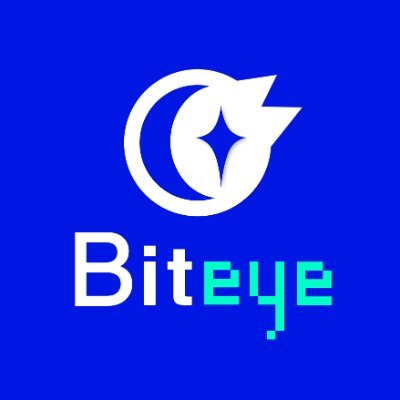Original author: Biteye core contributor Wilson Lee
Original translation: Biteye core contributor Crush
Farcaster is a decentralized social networking protocol that uses smart contracts and hybrid storage technology to enable social connections, content sharing, and data ownership among users, while supporting diverse and flexible client and application development.
In March of this year, Degen, a memecoin project of the Farcaster ecosystem, attracted widespread attention with a growth of more than 20 times and a market value of more than 1 billion US dollars, making the Farcaster ecosystem the focus of attention.
In May, Farcaster’s developer, Merkle Manufactory, announced it had completed a new round of financing led by Paradigm, totaling $150 million, raising the company’s valuation to $1 billion.
According to Dune data, Farcasters total number of users has reached 540,000, and the number of daily active users has surged from 2k at the beginning of the year to 56k at present, an increase of more than 28 times.
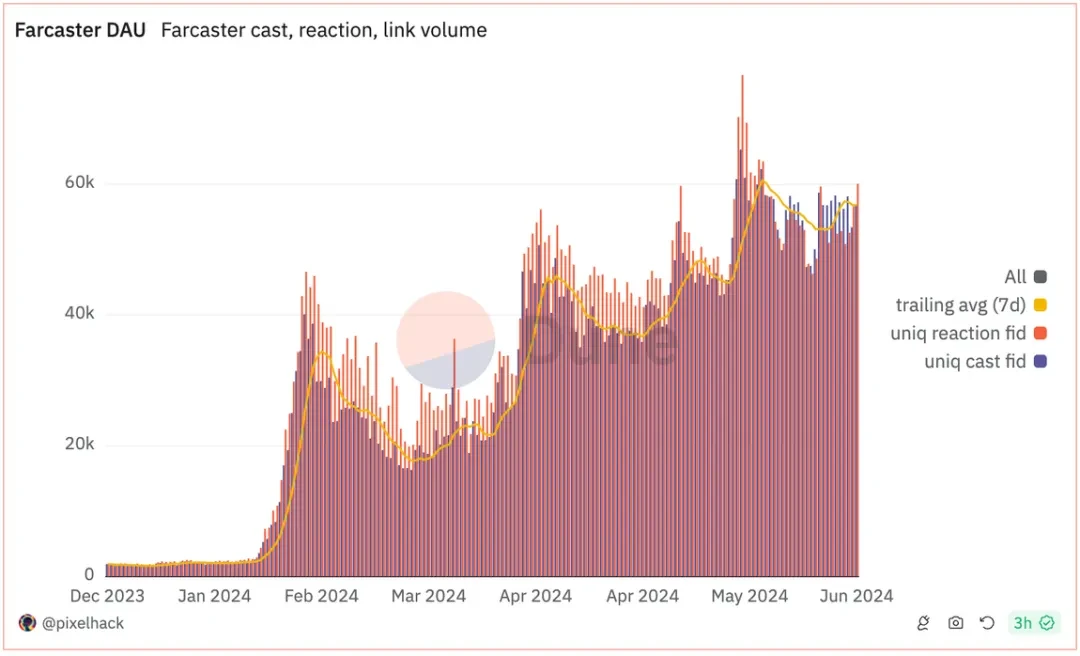
https://dune.com/pixelhack/farcaster
Farcaster is not a new social project. In the early testing phase, founder Dan used his personal influence and connections to invite many well-known OGs, including Vitalik Buterin, to join the project. He also screened early users by obtaining invitation codes through Twitter private messages, which made Farcasters user group have a very high concentration of elites.
This threshold-setting approach is intended to gather highly similar user groups in the early stages, making Farcaster a refined version of Twitter to some extent, where early users can enjoy a better posting and interaction experience.
In addition, users with early qualifications are usually influential KOLs. These users themselves have high social influence. Being able to experience Farcaster early may give them a certain sense of social superiority, and they will also have a stronger motivation to talk about and spread Farcaster on other platforms.
Last October, Farcaster opened registration but still set an entry threshold of $5. This move effectively blocked the registration of a large number of robot accounts and maintained the overall good atmosphere of Farcaster, which was in sharp contrast to Nostr, which had declined due to the proliferation of robots.
To date, Farcaster has raked in nearly $1.9 million in registration fees and data storage charges.
https://dune.com/pixelhack/farcaster
Farcasters two founders, Dan and Varun, both held important positions at Coinbase, which makes Farcaster closely linked to the Base ecosystem to some extent. Jesse, the core person in charge of the Base chain, is also very active on Farcaster.
From another perspective, among the top 500 users with the most followers on Farcaster, more than 70% of their on-chain interactions occurred on the Base chain.
Therefore, for those who are optimistic about the Base ecosystem, Farcaster is also seen as a potential Alpha treasure base.
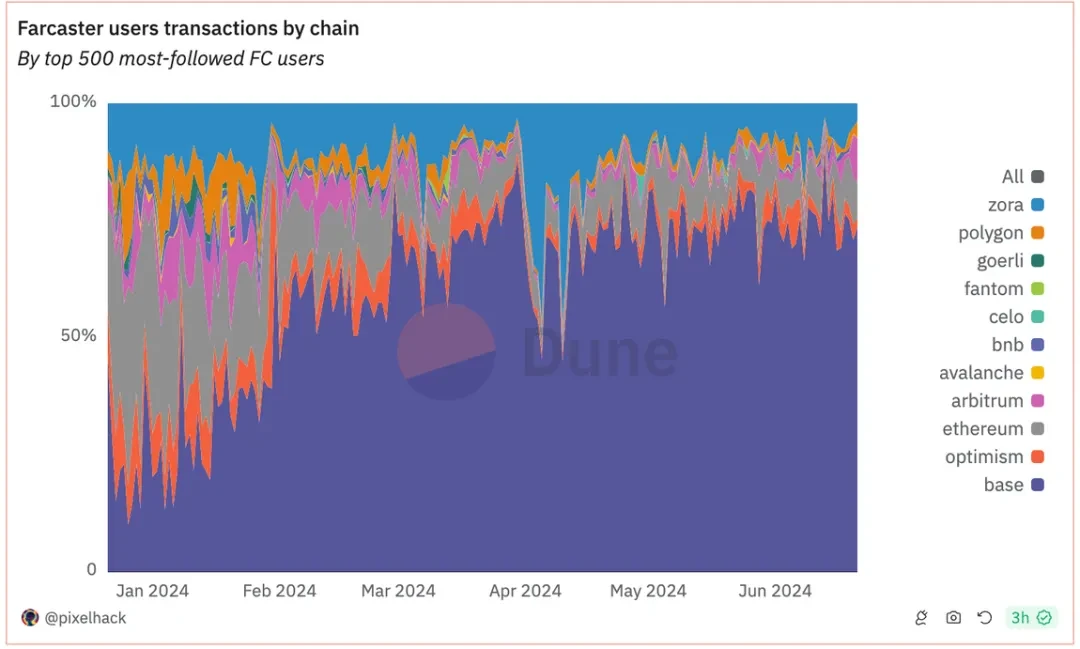
https://dune.com/pixelhack/farcaster
Farcaster protocol data is stored in hubs on and off the chain. Developers can choose to run hub nodes themselves or use third-party service providers like Neynar to obtain data.
All of this data is permissionless, and based on this available data, developers can build a variety of clients and applications, greatly increasing the richness and innovation space of the Farcaster ecosystem.
Users can track the progress of the ecosystem through the decaster website. Below is an introduction to some of the highlight projects.
01 WrapCast
Warpcast is the main application under the Farcaster protocol and the first Farcaster client. It was developed by a team of top engineers assembled by Dan for more than a year.
Its overall architecture is similar to traditional Web2 social software, with a smooth user experience. It currently accounts for 90% of Farcaster protocol traffic.
Warpcasts registration process is simple. The system will automatically generate a bound wallet for the user. All Warpcast accounts are associated with a Farcaster ID, and the generated content is stored in the Farcaster hub.
This design allows even non-cryptocurrency users to easily enter the on-chain world, greatly reducing the cognitive threshold for new users.
For users who are familiar with on-chain interactions, they can also bind their commonly used cryptocurrency wallets. These adjustments make Warpcast not only user-friendly, but also play an important role in promoting the growth of the Farcaster ecosystem and user acceptance.
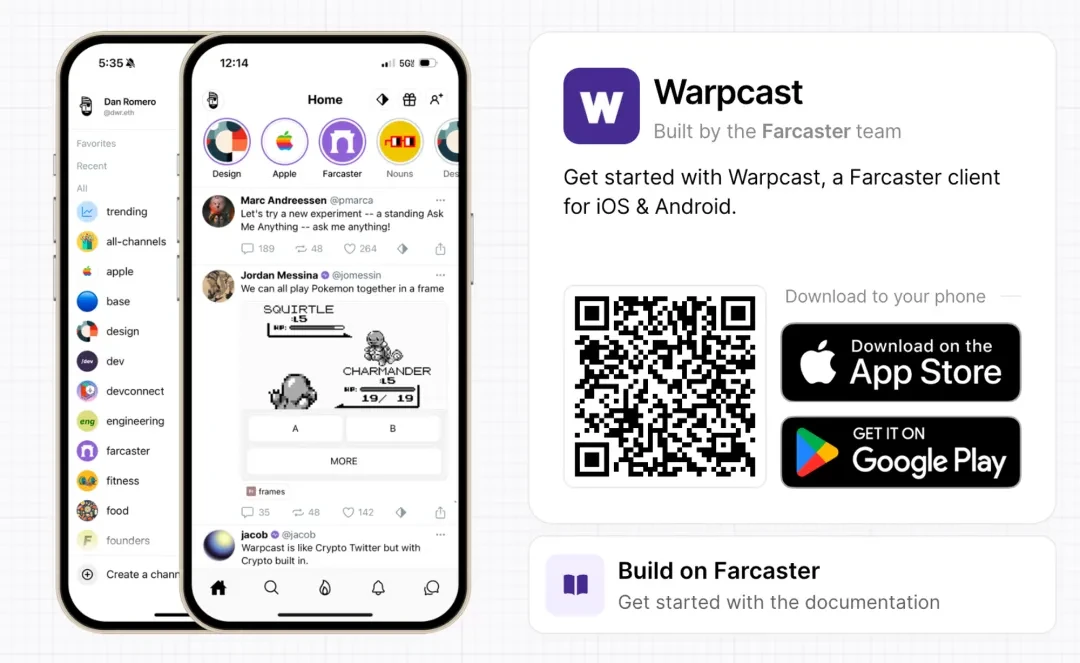
Warpcast is designed as a social platform similar to Twitter, where users can post tweets (casts), comment, retweet, and follow other users.
In addition to social media features similar to Twitter, Warpcast also introduced features such as channels and actions, which derive more ways of interaction.
For example, DEGEN uses the user participation in the Farcaster ecosystem to distribute tokens. Users can participate in DEGEN airdrops by following channels and interacting. The airdropped tokens can be given as rewards to other users.
Farcaster’s huge growth this year is closely related to the Frames feature launched in February. Frames is a mini-app embedded in Warpcast, which allows users to interact in a more diverse way without leaving Warpcast, such as minting NFTs, subscribing to content, playing mini-games, and receiving tokens.
For example, far.cards is a trading card project developed based on mint.club and exclusively for Farcaster users. The attribute value of each users card depends on their activity on Farcaster, such as the number of fans, likes and replies received, etc.
The price of the card is determined by the bonding curve. The purchased cards can be collected or traded.
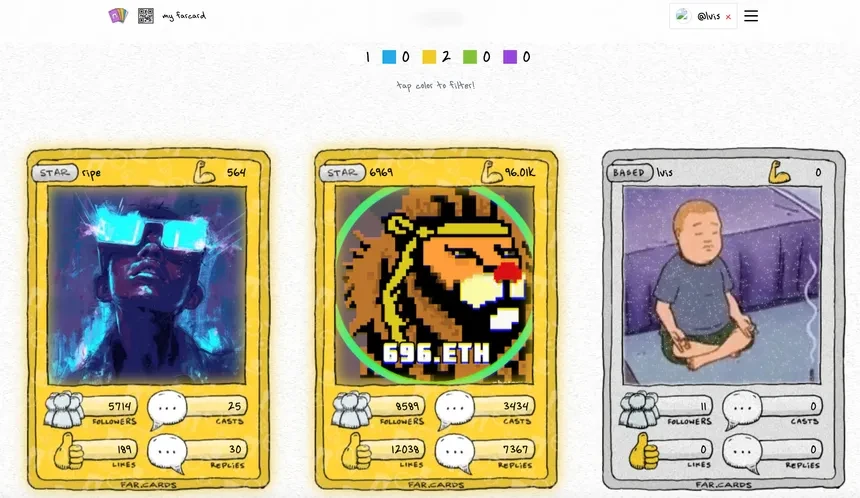
As shown in the figure below, the far.cards application can be published in a tweet as a Frame. Users who see the tweet can directly purchase its cards through the Frame without leaving the Warpcast client.
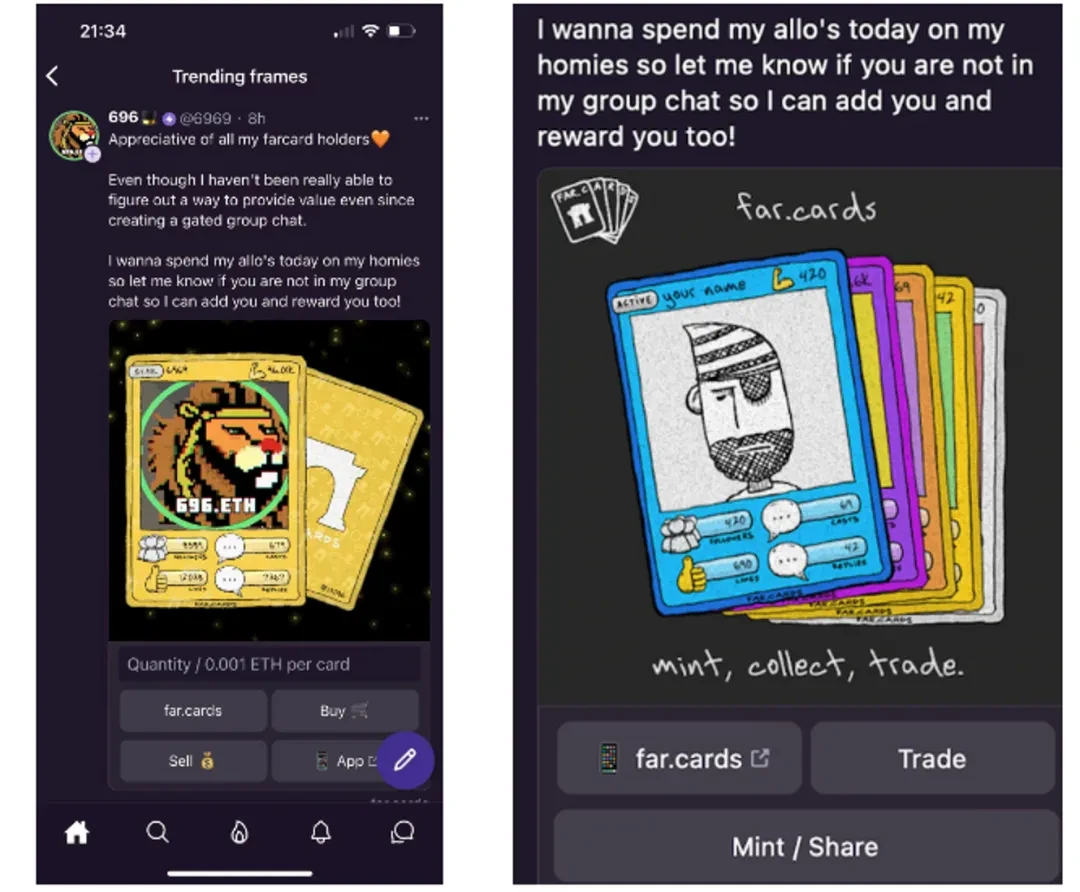
The launch of Frames has greatly enriched the playability of Warpcast, making Farcaster development no longer limited to building a decentralized Twitter.
Currently, nearly 40,000 users have used the Frames function, generating more than 150,000 on-chain transactions, and the number of interactive contracts designed has reached 1,624.
https://dune.com/jhackworth/frames
Frame is similar to MiniApp in the Ton ecosystem in terms of user experience. Although Farcaster currently cannot have a large user base like Ton, it is also necessary to pay attention to Frame mini-games that are very simple and easy to spread, such as Not a coin on Ton.
Referring to the success of the DEGEN project in terms of market value and communication capabilities, it is entirely possible that there will be projects on Farcaster that distribute tokens with high returns through the Frame applet.
Degen.Game is a website that organizes Frame applets. Users can log in with their Farcaster identity to view the latest Frame every day and interact with it.
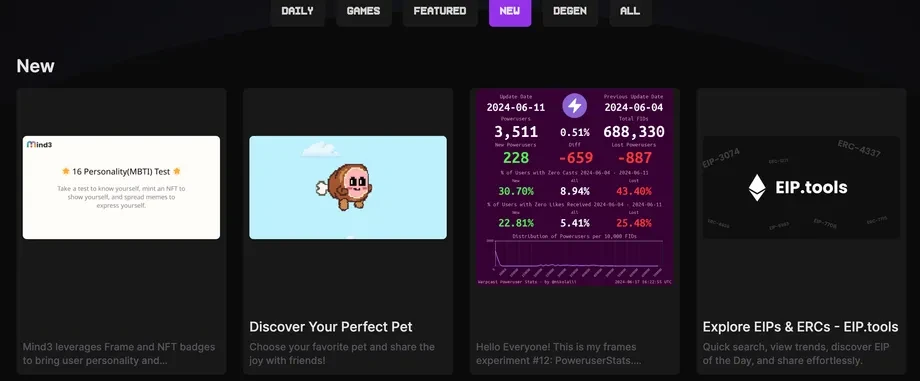
https://www.degen.game/frames/new
02 Jam
Jam is a creator economy platform based on Farcaster that can convert every tweet of a user on Warpcast into an NFT asset similar to Friend.tech Key. Users can buy/sell each tweet, and the price is determined by the Bonding Curve as shown in the figure below.
Jams trading volume exceeded $10 million within 72 hours of its launch.
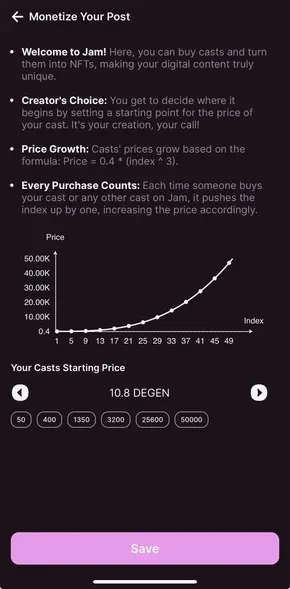
The first use of Jam costs 10 warp points, and 100 warp points are given when you register Farcaster.
After binding your Farcaster account, you can view the push stream on the homepage to find tweets worth minting. The Top list includes tweets with the most recent transactions and the latest tweets. The Trades section shows the real-time record of tweet transactions.
Unlike Friend.tech, each tweet can only have one holder at a time, so there is no situation where you rush to open a bunch of shares and then sell them. However, the idea of profit is similar. You need to find and buy tweets that may be contagious as early as possible. The targets of attention include Farcaster core developers, Vitalik Buterin, KOLs, etc., to ensure that there are other buyers to take over later.
If you are a KOL or someone who is good at tweeting and has a good sense of the internet, you can also earn a 5% transaction fee by constantly writing tweets and making memes to spread them.
Jam currently does not have tokens, but it does have internal points. Considering that the overall gameplay is very similar to Friend.tech, the potential airdrop may be considerable.
03 Clubcast
ClubCast is an application on Farcaster similar to Knowledge Planet. It has enabled the token-gated casts function. Users need to pay to purchase other users club tokens before they can unlock and view hidden content in clubcast.xyz or Frame. Currently, developer permission is required for use.
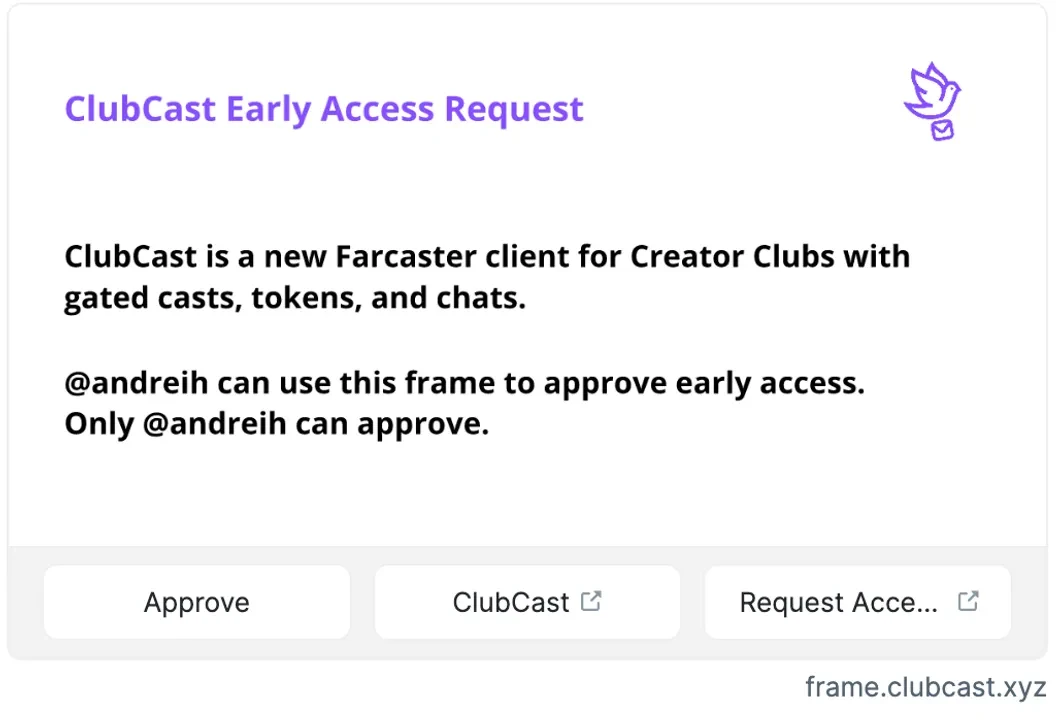
04 BountyCaster
BountyCaster is a task platform built on the Farcaster protocol, founded by Linda Xie (former co-founder of Scalar Capital and product manager of Coinbase).
As shown in the figure below, users can add the tag @Bountybot to publish tasks when sending content on clients such as Warpcast, and other users can take on the corresponding tasks and receive corresponding rewards.
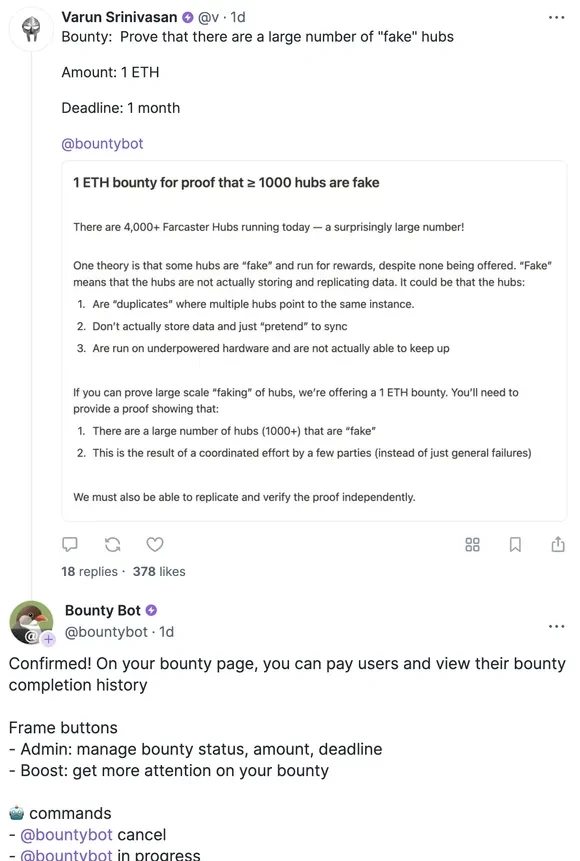
Similarly, you can also publish the services and prices you can provide. Users need to log in with their Farcaster account to view published bounties, available services, and even job opportunities on the BountyCaster website.
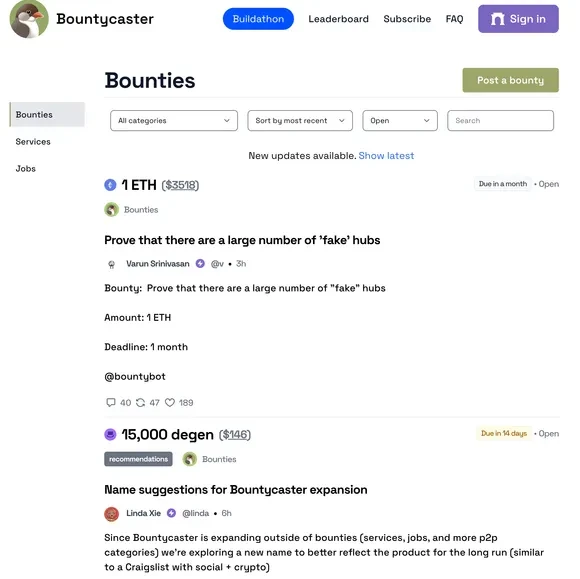
05 AlfaFrens
AlfaFrens is a creator economy application built on the Base ecosystem and the Farcaster protocol, developed by Superfluid, which supports on-chain asset flows.
Similar to Friend.tech, users can subscribe to KOL channels and access exclusive chat rooms, and further obtain tokens produced by the channels.
There are two currencies in the platform, $Degen and $ALFA. $Degen is an ERC 20 token on the Base chain, and $ALFA is a proprietary token of the AlfaFrens platform, which can only be obtained within the platform and cannot be transferred.

$Degen is the consumable token of the platform. When starting to use AlfaFrens, users need to prepare some $Degen and deposit it into the wallet generated by the platform.
Users can use $Degen to subscribe to KOL channels, which are divided into three levels: 500, 1000 and 1500 $Degen/month.
Subscription fees are consumed linearly, and users can cancel their subscriptions at any time. 70% of the subscription fee is distributed to users who stake $ALFA to the channel according to the staking ratio.
The platform will generate $ALFA tokens every day, and each channel will distribute the allocated $ALFA equally to subscribed users based on the amount of $Degen obtained from subscriptions.
Therefore, you can find a popular KOL subscription channel and stake the $ALFA tokens you have obtained to the channel to earn more $Degen.
$ALFA is not a circulating token yet and has no price. In the early stage, $Degen is used to exchange for $ALFA. Therefore, different participation strategies can be formulated based on profit preferences (wanting more $DEGEN with existing value or more $ALFA that has not yet been priced).
06 Conclusion
As people become more and more accustomed to living on the Internet, social graphs have become important personal assets, and users demand for data autonomy is also increasing.
Web3s solutions are naturally suited to solving the pain points of current Web2 social platforms, but the decentralized social sector has not achieved particularly great success.
Many projects are too focused on decentralization, but ignore the importance of user experience. Dan pointed out in an interview with Bankless that the positioning of Web3 social networking is not to replace Web2 social networking, but to improve it, allowing users to have more on-chain gameplay while owning data, and do things that cannot be done in Web2.
https://www.youtube.com/watch?v=nGDIdbdtdjEt=1343sab_channel=Bankless
Farcaster significantly improves the smoothness of user interaction by storing valuable data on-chain and high-frequency data off-chain.
The team has attached great importance to mobile development from the very beginning, and they are well aware that mobile devices are the main usage scenario for social software.
Therefore, the Warpcast client has a good user experience, is fully functional, and has a fast iteration speed. It constantly introduces new features such as long text and interactive functions (action), providing developers with more and more capabilities to build new applications.
Although Farcaster is far from perfect and still has a lot of room for improvement, it is already an application that can attract users and maintain growth. More excellent products based on Farcaster will surely emerge in the future. Let us look forward to and pay attention to the development of Farcaster and participate in it as soon as possible.

